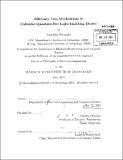Efficiency loss mechanisms in colloidal quantum-dot light-emitting diodes
Author(s)
Shirasaki, Yasuhiro
DownloadFull printable version (15.63Mb)
Other Contributors
Massachusetts Institute of Technology. Department of Electrical Engineering and Computer Science.
Advisor
Vladimir Bulović.
Terms of use
Metadata
Show full item recordAbstract
Saturated and tunable emission colors make colloidal quantum-dot light-emitting diodes (QD-LEDs) interesting for the next generation of display and lighting technologies. However, there still remain various hurdles to the commercialization of QD-LEDs, including their relatively low external quantum efficiencies (EQE). In this thesis, we study the efficiency loss mechanisms present in the latest generation of QD-LEDs. We start with understanding the origin of reduced efficiencies at high current density operation, known as the efficiency roll-off. Through simultaneous measurement of quantum dot (QD) electroluminescence (EL) and photoluminescence (PL) efficiencies during device operation, we identify that the reduced PL efficiency of the QDs at high current densities is the cause for the efficiency roll-off. Furthermore, comparison of QD EL spectra, taken under forward bias, and PL spectra, taken under reverse bias, suggests that this reduced PL efficiency is electric-field-induced. We use the relationship between PL peak-shifts and PL quenching of QDs subject to the quantum confined Stark effect to predict the efficiency roll-off in forward bias. The roll-off predicted by this analysis is in excellent agreement with our experimental data and correctly traces an EQE reduction of nearly 50%. We complement the ELPL study with electroabsorption spectroscopy measurements of a biased QD-LED, which confirms that the charging of the QDs is not voltage bias dependent and is thus unrelated to the roll-off. Finally, we study the effect of Auger recombination on QD-LEDs by varying the QD layer thickness. QD-LEDs with thicker QD layers exhibit lower peak EQEs and QD transient PL with stronger bi-exponential behavior. We attribute the strength of the bi-exponential behavior to the fraction of the QDs charged in the device, which can explain the correlation between the strength of the bi-exponential behavior and the EQE.
Description
Thesis (Ph. D.)--Massachusetts Institute of Technology, Dept. of Electrical Engineering and Computer Science, 2013. Cataloged from PDF version of thesis. Includes bibliographical references (p. 135-147).
Date issued
2013Department
Massachusetts Institute of Technology. Department of Electrical Engineering and Computer SciencePublisher
Massachusetts Institute of Technology
Keywords
Electrical Engineering and Computer Science.